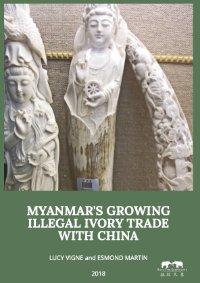By Lucy Vigne and Esmond Martin
Executive summary ■ From 2013 to 2016, Laos’s retail ivory market has expanded more rapidly than in any other country surveyed recently. ■ Laos has not been conforming with CITES regulations that prohibit the import and export of ivory. Since joining CITES in 2004, only one ivory seizure into Laos has been reported to the Elephant Trade Information System (ETIS). ■ Almost no arrests, let alone prosecutions and punishments, have been made of smugglers with ivory coming in or out of the country. ■ Most worked ivory for sale in Laos originates from elephants poached in Africa. ■ Ivory has also been entering Laos illegally from Thailand, as Thai traders have been offloading their ivory following the imposition of much stricter regulations there. ■ In late 2013 the average wholesale price of raw ivory sold by Lao traders peaked at about USD 2,000/kg. ■ By late 2016, the average wholesale price of raw ivory in Laos had declined to USD 714/kg, in line with prices elsewhere in the region. This price was much higher than in African countries, such as Sudan (Omdurman/Khartoum), where the average wholesale price of ivory was USD 279/kg in early 2017. This price differential is due to the extra expenses incurred in transport and bribes to government officials on the long journey to Asia. ■ In Laos, the decline in the wholesale price of raw ivory between 2013 and 2016, as elsewhere in the region, was mainly due to the slowdown in China’s economy, that resulted in an oversupply of illegal ivory, relative to demand. ■ Ivory items seen for sale in Laos are carved or machine-processed in Vietnam by Vietnamese and smuggled into Laos for sale, or are processed by Chinese traders in Laos on new computerdriven machines. Ivory carving by Lao people is insignificant. ■ In Laos, the survey found 81 retail outlets with ivory on view for retail sale, 40 of which were in the capital, Vientiane, 21 in Luang Prabang, 8 in Kings Romans, 5 in Oudom Xay, 3 in Pakse, 2 in Dansavanh Nam Ngum Resort and 2 in Luang Nam Tha. ■ The survey counted 13,248 ivory items on display for sale, nearly all recently made to suit Chinese tastes. Vientiane had 7,014 items for sale, Luang Prabang 4,807, Kings Romans 1,014, Dansavanh Nam Ngum Resort 291, Oudom Xay 93, Luang Nam Tha 16, and Pakse 13. ■ Most outlets, displaying the majority of worked ivory, also sold souvenirs, Chinese herbal teas or jewellery, or were hotel gift shops. ■ Outlets were usually owned by traders from mainland China. The number of Chinese-owned shops had risen in Laos from none recorded in the early 2000s to several in 2013, including one main shop in Vientiane’s Chinese market and two on the main tourist street of Luang Prabang. By 2016, there were 22 and 15 outlets, respectively, in these two areas, both of which are popular with Chinese visitors. By 2016, Chinese outlets with ivory had also sprung up in other locations, mainly those visited by the increasing number of Chinese. ■ In 2016, the most common ivory items for sale were pendants, followed by necklaces, bangles, beaded bracelets and other jewellery, similar to items for sale in 2013, but in far larger quantities. ■ The least expensive item was a thin ring for USD 3 and the most expensive was a pair of polished tusks for USD 25,000. ■ Retail prices for ivory items of similar type were higher than elsewhere in Kings Romans, which is visited primarily by wealthier Chinese visitors with money to spend. ■ Mainland Chinese buy over 80% of the ivory items in Laos today. There are sometimes buyers from South Korea and other Asian countries, according to vendors. ■ Laotians today generally buy amulets that are made of bone or synthetic material, rather than ivory items.
Nairobi, Kenya: Save the Elephants, 2027. 92p.








